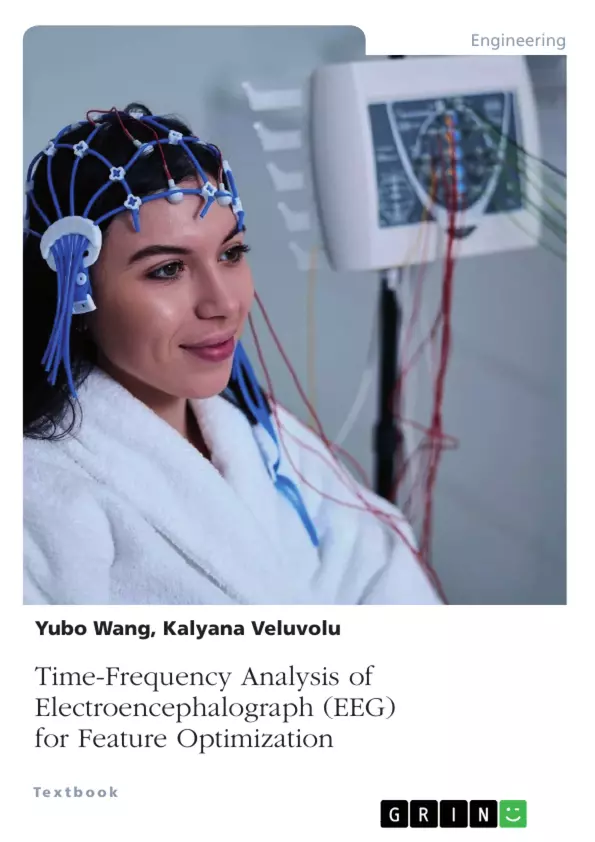Electroencephalograph (EEG) has been widely used for BCI applications due to its non-invasiveness, ease of implementation, and cost-efficiency. The collected EEG signal is non-stationary and has task-related information buried in the frequency and temporal domains. In this book, we focused on developing time-frequency decomposition methods for improving the feature extraction module in BCI systems. The obtained features are then optimized by identifying subject-specific reactive band and employing evolutionary algorithm-based methods for optimizing the obtained features, improving the BCI systems' performance.
A signal model named as band-limited multiple Fourier linear combiner (BMFLC) is employed to model the non-stationarity in the EEG signal for feature extraction. The non-stationary amplitude oscillation is presented as adaptive weights in the model and estimated with various adaptive filters such as least-mean square (LMS), Kalman filter (KF), or Kalman Smoother (KS). The estimated coefficients serve as features for classification. Our results suggest that the BMFLC-LMS, BMFLC-KF, and BMFLC-KS are all sufficient in modeling EEG signal in the band with average estimation accuracies of 93%, 99%, and 98%, respectively. We modelled motion-induced EEG signal in frequency domain. We found that most subjects present a subject- specific reactive band during motion tasks. We then constructed features for a classifier that used only the frequency information in the subject-specific reactive band. As a result, the classification accuracy of the BCI system is improved compared to the system which uses the complete band information. Features obtained from multiple EEG channels need to be optimized to enhance the performance of the BCI systems. Essentially, two problems need to be resolved: 1) volume conduction; 2) dimensionality. The volume conduction can be mitigated if spatial filter is employed, and the dimension of the feature vector can be reduced if a feature selection procedure is adopted. An evolutionary algorithm (EA) based approach was developed to estimate spatial filter and reduce feature dimension simultaneously. We show that the BMFLC-KF combined with the evolutionary al- algorithm has the highest classification accuracy compared to other BMFLC-KF based approaches and is superior to the traditionally employed band-power methods.
Table of Contents
- Introduction
- Background
- Motivations
- Contribution of the Thesis
- Organization of the Thesis
- Literature Review
- EEG for BCI
- ERD/ERS-based BCI Systems
- Feature Extraction of the ERD in EEG
- Feature Optimization for BCI
- Subject-specific Reactive Band Identification with BMFLC-LMS
- Single Trial ERD Detection with Multiple BMFLC-LMS
- Time-frequency Decomposition of EEG Signal with BMFLC Kalman Filter/Smoother
Objectives and Key Themes
This book explores the use of time-frequency decomposition methods for improving feature extraction in brain-computer interface (BCI) systems. The research focuses on developing effective techniques for modeling the non-stationary nature of electroencephalogram (EEG) signals, identifying subject-specific reactive bands, and optimizing extracted features to enhance BCI performance.
- Time-frequency decomposition of EEG signals
- Feature extraction in BCI systems
- Subject-specific reactive band identification
- Feature optimization techniques
- Performance enhancement of BCI systems
Chapter Summaries
The book begins with an introduction to EEG-based BCIs, outlining their applications, limitations, and the motivations behind this research. Chapter 2 provides a comprehensive literature review on EEG signal analysis for BCI applications, including event-related desynchronization (ERD) and synchronization (ERS), feature extraction methods, and feature optimization techniques. Chapter 3 focuses on subject-specific reactive band identification using the band-limited multiple Fourier linear combiner (BMFLC) with the least mean square (LMS) algorithm. Chapter 4 delves into single-trial ERD detection using multiple BMFLC-LMS, exploring methods for time-frequency decomposition and reactive band identification in single-trial EEG data. Chapter 5 investigates the application of Kalman filter and smoother techniques for time-frequency decomposition of EEG signals using BMFLC, aiming to improve the accuracy of feature extraction.
Keywords
This book focuses on the key concepts of brain-computer interface (BCI), electroencephalogram (EEG), time-frequency analysis, feature extraction, feature optimization, subject-specific reactive band, band-limited multiple Fourier linear combiner (BMFLC), least mean square (LMS), Kalman filter, Kalman smoother, event-related desynchronization (ERD), and BCI performance enhancement.
- Quote paper
- Kalyana Veluvolu (Author), Yubo Wang (Author), 2017, Time-Frequency Analysis of Electroencephalograph (EEG) for Feature Optimization, Munich, GRIN Verlag, https://www.grin.com/document/1168520



